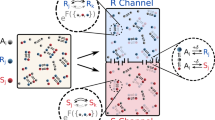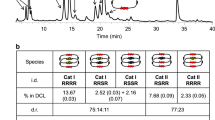Abstract
A fairly simple and original one-stage method of obtaining optically active attractants ofPorthetria dispar-(+)- and (-)-2-methyl-Z- and E-7,8-epoxyoctadecanes has been developed. The synthesis is based on the epoxidation of 2-methyloctadec-Z-and -E-7-enes by chiral peroxide complexes of molybdenum of the type of MoO3-L* in an organic solvent at room temperature. Derivatives of tartaric, lactic, β-aminopropionic, and aspartic acids have been used as the chiral ligands (L*).
Similar content being viewed by others
Literature cited
D. A. Evans and C. L. Green, Chem. Soc. Rev.,2, 75 (1973).
K. Eiter, Insekten-Sexuallockstoffe. Chemie der Pflanzenschutz und Schadlingbekampfungsmittel, Springer Verlag, Berlin, Vol. 1 (1970), pp. 497–522.
P. Karlson and D. Schneider, Naturwissenschaften,60, 113 (1973).
M. Jacobson, Insect Sex Attractants, Wiley, New York (1966).
(Russian translation of [4]).
I. R. Reimmer, C. P. Schalbe, E. C. Razzeh, B. A. Bierl, R. E. Welb, S. Marumo, and I. Iwaki, Entomol.,6, No. 4, 518 (1977).
S. Iwaki, S. Marumo, T. Saito, M. Yomada, and K. Katagiri, J. Am. Chem. Soc.,96, 7842 (1974).
K. Mori, T. Takigawa, and M. Matsui, Tetrahedron Lett., 3953 (1976).
W. H. Pirkle and P. L. Rinaldi, J. Org. Chem.,44, 1025 (1979).
B. Kagan, H. Mimoun, C. Mark, and V. Schurig, Angew. Chem.,91, 511 (1979).
H. Mimoun, I. Seree de Roch, and L. Sajus, Bull. Soc. Chim. Fr., 1481 (1969).
U. M. Dzhemilev, G. G. Balezina, G. A. Tolstikov, and V. P. Krivonogov, Khim. Prirodn. Soedin., 792 (1978).
V. Sh. Fel'dblyum, The Dimerization and Disproportionation of Olefins [in Russian], Moscow (1978).
Beilsteins Handbuch der Organ. Chem., Berlin,1, I, 363 (1928).
Chem. Abstr.,46, 8635 (1952);26, 51755 (1932);41, 5091 (1947).
K. Tani, M. Hanafusa, and S. Otsuka, Tetrahedron Lett., 3017 (1979).
A. N. Kost, B. G. Kovalev, E. D. Matveeva, V. V. Stan, L. G. Yudin, Yu. A. Elizarov, and M. N. Barybkina, Bioorgan. Khim.,3, 934 (1977).
Additional information
Institute of Chemistry of the Bashkir Branch of the Academy of Sciences of the USSR, Ufa. Translated from Khimiya Prirodnykh Soedinenii, No. 5, p. 650–657, September–October, 1981.
Rights and permissions
About this article
Cite this article
Dzhemilev, U.M., Fakhretdinov, R.N., Telin, A.G. et al. A new approach to the synthesis of optically active disparlures — Attractants ofPorthetria dispar . Chem Nat Compd 17, 482–487 (1981). https://doi.org/10.1007/BF00565169
Received:
Published:
Issue Date:
DOI: https://doi.org/10.1007/BF00565169




